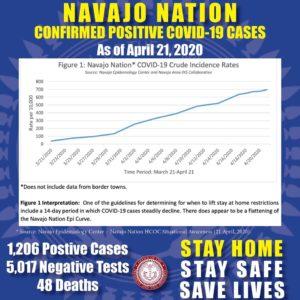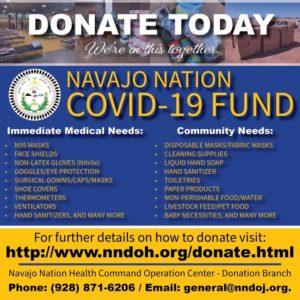By Recker McDowell —
There are more than 1,200 reported cases and 48 deaths from COVID-19 on the Navajo Nation.
That is more cases than 8 U.S. states including Alaska and North Dakota. There are also more cases than Pima County. The 48 Navajo Nation deaths from the Coronavirus are more than 13 states including Nebraska and South Dakota.
The Navajo reservation has a population of just under 357,000.
The pandemic has exposed some glaring holes and disparities in the U.S. health care system and our society as a whole. The Navajos are seeing more cases and deaths than U.S. cities such as Austin, Texas and Portland, Oregon.
Limited access to health care, pre-existing conditions and historical and contemporary inadequacies (and injustices) in medical investments and infrastructure are all magnifying COVID-19’s impact on the Navajo Nation and in other Native American communities.
This should be a call to action in Arizona, other states and nationally. Native Americans are making up significant portion of COVID-19 cases in Arizona and New Mexico.
This should be a call to action and investments considering the history of mistreatment of indigenous peoples.
President Trump, members of Congress and governors have all talked about infrastructure investments to help the economy after the pandemic.
We should start with places like the Navajo Nation where jobs are scarce, access to health care limited and staffing shortages challenge hospitals, schools, and clinics.
In the short-term, we need to get medical equipment, frontline employees, tests to the Navajo Nation. We have seen equipment and resources deployed to other hot spots including New York City. We need the same for the Navajo Nation which spans across parts of Arizona, New Mexico, and Utah.
Investing in Native American and other rural communities both in terms of improving access to medical care and job opportunities must be a priority. Areas of the Navajo Nation and other rural tribes lack clean and sometimes running water and internet access.
This is unacceptable in America in the 21st Century.
We need to take significant bites out of diabetes, asthma and other long-term ‘pre-existing’ conditions that make COVID-19 especially dangerous.
Rural communities also need more housing and economic development options to help staff hospitals and schools and businesses. A major challenge for Native American and rural areas is that teachers, nurses, and others cannot find adequate housing. More job opportunities (including the private sector) are needed for residents and so the spouses and partners of nurses, doctors and teachers can also find opportunities.
We need the private sector, nonprofits and other communities and institutions including universities to step forward and lead this effort. The record of government ‘help’ for Native Americans is historically abysmal to say they least. We need innovators, entrepreneurs, creatives, and others to make a commitment to lift up communities.
We know we need national improvements in our health system including supply chains.
 The disparities do not stop with Native Americans. African Americans make up 13.4 percent of the U.S. population but 33.7 percent of COVID-19 cases, according to the U.S. Centers for Disease Control. Hispanics make up 23 percent of all Coronavirus cases nationwide and 18 percent of the U.S. population.
The disparities do not stop with Native Americans. African Americans make up 13.4 percent of the U.S. population but 33.7 percent of COVID-19 cases, according to the U.S. Centers for Disease Control. Hispanics make up 23 percent of all Coronavirus cases nationwide and 18 percent of the U.S. population.
These numbers should also be a focus as we look at how to improve our health care system and fix its problems and our social and economic inequities.

